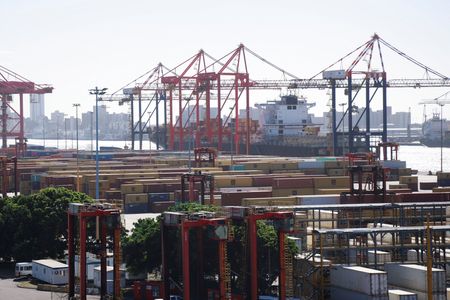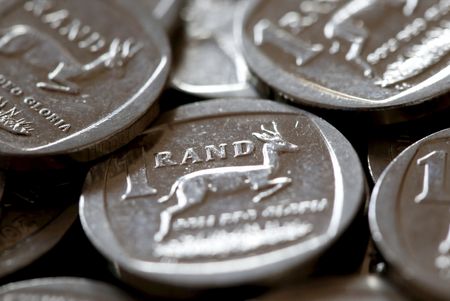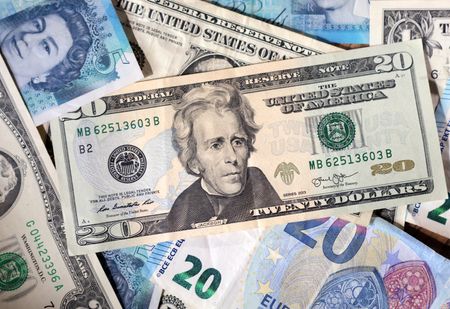By Wayne Cole and Alun John
SYDNEY/LONDON (Reuters) -Stocks marked time on Monday, holding just shy of peaks scaled in late July, as investors awaited a crucial report on U.S. inflation that will likely also set the course of the dollar and bonds.
Trade and geopolitics also loom large for investors this week. A U.S. tariff deadline on China, due to expire on Tuesday, is expected to be extended again, while U.S. President Donald Trump and Russian leader Vladimir Putin are due to meet in Alaska on Friday to discuss ending the Ukraine war.
S&P 500 futures were last up 0.16%, with Europe’s STOXX 600 share index flat on the day after Asia-Pacific stocks had gained 0.3%.
That leaves MSCI’s world share index around 0.2% below its all-time high hit in late July as a strong earnings season in the United States, and a mildly positive one in Europe, support overall sentiment, helping investors to shrug off the impact of soft U.S. July jobs data.
The main economic release this week will be U.S. consumer prices on Tuesday, with analysts expecting the impact of tariffs to help nudge the core up 0.3% to an annual pace of 3% and away from the Federal Reserve target of 2%.
An upside surprise would challenge market wagers for a September rate cut, though analysts assume it would have to be a very high number given that a downward turn in payrolls is now dominating the outlook.
It also comes at a complicated time for the Fed, with Trump having repeatedly criticised policymakers for not cutting rates at recent meetings, and with the focus on who will succeed current chair Jerome Powell, whose term ends in May.
This, said Paul Mackel, Global Head of FX Research at HSBC, meant that the dollar’s reaction to the CPI data would not be straightforward.
If the figure indicated higher U.S. tariff price pressures, “that could support the stagflation narrative, and to the dollar’s detriment”, he said, adding this would also go against the view of some policymakers that tariffs were not causing prices to increase.
“If, however, softer U.S. CPI readings materialise, including the core goods figures, this would likely challenge the dollar too by supporting the case for further Fed easing, and perhaps see greater criticism from the U.S. administration towards Fed Chair Powell.”
Markets imply around a 90% probability of a September easing, and at least one more cut by year-end.
That has helped support Treasuries, and the U.S. benchmark 10-year yield was last at 4.27%, down around 1 basis point and hovering near last week’s low of 4.187%. [US/]
The prospect of lower borrowing costs has supported equities, along with a run of strong earnings, particularly from tech names.
Analysts were unsure what to make of reports, including by Reuters, that Nvidia and AMD have agreed to give the U.S. government 15% of their revenues from chip sales in China, under an arrangement to obtain export licences for the semiconductors. Shares of both companies were marginally lower in pre-market trading.
CHINA EXPORTS DEFLATION
Chinese blue chips added 0.4% after data showed consumer price inflation ticked up in July, but producer prices kept falling as the country’s massive manufacturing sector exported deflation to the rest of the world.
Figures on Chinese industrial output and retail sales for July are due on Friday, and forecasts are for a slight slowdown after a jump in the previous month.
Currencies were quiet, with early trading thinned by a holiday in Japan. The euro was marginally softer at $1.1627 while the dollar inched up to 147.87 yen.
The Australian dollar eased to $0.6510 ahead of a meeting of the Reserve Bank of Australia, which is widely expected to back a rate cut. It stunned markets in July by skipping an easing of policy to await more inflation data.
In commodity markets, gold fell 1.3% to $3,354 an ounce after wild swings last week on reports that the U.S. would slap 39% tariffs on some gold bars, which are major exports of Switzerland. [GOL/]
The White House has said it planned to issue an executive order clarifying the country’s stance.
Oil prices stabilised as investors looked ahead to the talks between Trump and Putin in Alaska on Friday, with U.S. policy towards Russian oil exports in focus. [O/R]
Brent rose 0.6% to $66.99 a barrel, while U.S. crude gained 0.5% to $64.20.
(Reporting by Wayne Cole in Sydney and Alun John in London; Editing by Sonali Paul, Gareth Jones and Alex Richardson)











